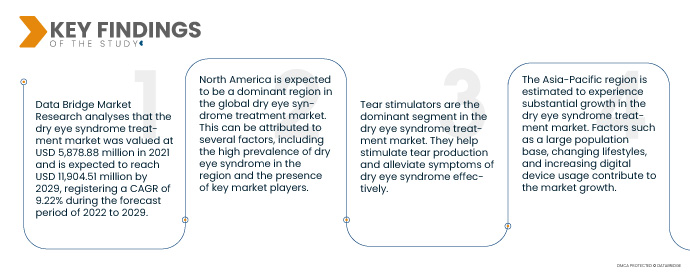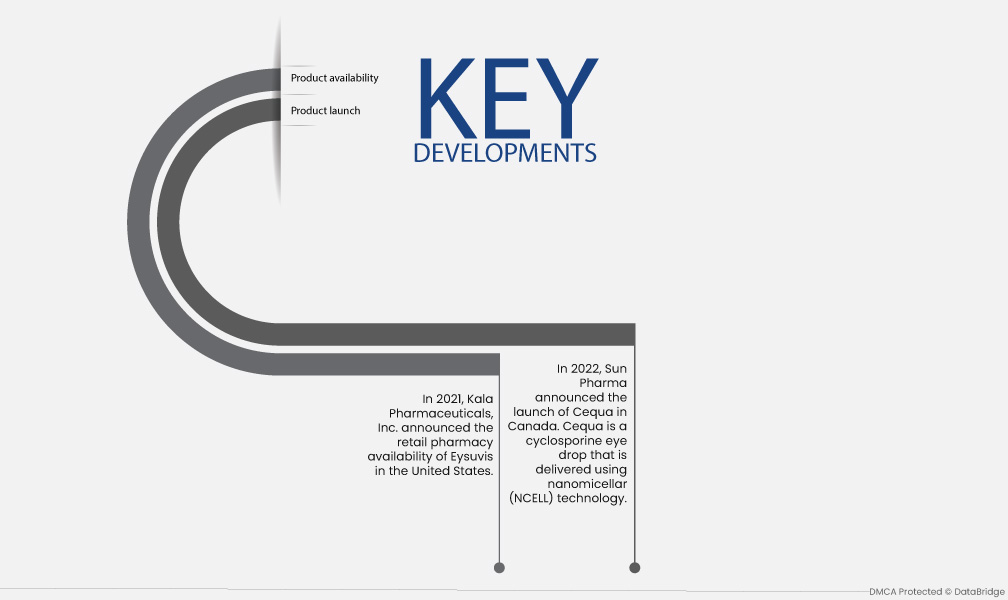В 2021 году сегмент розничных аптек имел самую высокую долю выручки в 45,1%. Это связано с удобством розничных аптек. Кроме того, наличие фармацевтов в некоторых местах для помощи с дозировками, обслуживанием клиентов и консультациями помогает сегменту получить конкурентное преимущество на рынке. Ожидается, что сегмент интернет-аптек будет развиваться самыми быстрыми темпами в 8,4% в течение прогнозируемого периода из-за увеличения числа потребителей, покупающих товары для удобства. Кроме того, из-за ограничений на передвижение людей эпидемия увеличила использование интернет-аптек. Кроме того, наличие более низких цен в этих интернет-магазинах стимулирует повторные покупки.
Полный отчет доступен по адресу https://databridgemarketresearch.com/reports/global-dry-eye-syndrome-treatment-market
Data Bridge Market Research анализирует, что рынок лечения синдрома сухого глаза был оценен в 5 878,88 млн долларов США в 2021 году и, как ожидается, достигнет 11 904,51 млн долларов США к 2029 году, регистрируя среднегодовой темп роста в 9,22% в прогнозируемый период с 2022 по 2029 год. Ожидается, что мировой рынок лечения синдрома сухого глаза будет демонстрировать значительный рост из-за растущей распространенности синдрома сухого глаза и внедрения передовых вариантов лечения. Технологические достижения и кампании по повышению осведомленности также являются способствующими факторами. Ключевые игроки на рынке активно участвуют в исследованиях и разработках, чтобы вывести на рынок инновационные решения.
Ожидается , что растущая распространенность синдрома сухого глаза будет способствовать темпам роста рынка.
Во всем мире растет число случаев синдрома сухого глаза из-за старения населения, экологических условий и длительного использования цифровых устройств. Внедрение инновационных диагностических инструментов и передовых методов лечения, таких как трансплантация амниотической мембраны и интенсивная импульсная световая терапия. Расширение кампаний по повышению осведомленности и образовательных инициатив для содействия ранней диагностике и лечению синдрома сухого глаза.
Область отчета и сегментация рынка
Отчет Метрика
|
Подробности
|
Прогнозируемый период
|
2022-2029
|
Базовый год
|
2021
|
Исторические годы
|
2020 (можно настроить на 2014-2019)
|
Количественные единицы
|
Доход в млн. долл. США, объемы в единицах, цены в долл. США
|
Охваченные сегменты
|
Тип продукта (стимуляторы слезоотделения, искусственные слезы, средства, усиливающие секрецию, другие), тип дозировки (жидкие, полутвердые, другие), лечение (смазывающее средство, холинергические средства, противовоспалительные, противоинфекционные, противоаллергические средства, другие), доза (единичная доза, многодозовая), тип лекарства (рецептурные препараты, безрецептурные препараты ), тип контейнера (флаконы с единичной дозой, бутылки, тубы), тип упаковки (пластик, алюминий, стекло), тип (бренды, дженерики), канал сбыта (больничная аптека, розничная аптека, интернет-аптека), конечные пользователи (больницы, уход на дому, специализированные клиники, другие)
|
Страны, охваченные
|
США, Канада и Мексика в Северной Америке, Германия, Франция, Великобритания, Нидерланды, Швейцария, Бельгия, Россия, Италия, Испания, Турция, Остальная Европа в Европе, Китай, Япония, Индия, Южная Корея, Сингапур, Малайзия, Австралия, Таиланд, Индонезия, Филиппины, Остальная часть Азиатско-Тихоокеанского региона (APAC) в Азиатско-Тихоокеанском регионе (APAC), Саудовская Аравия, ОАЭ, Южная Африка, Египет, Израиль, Остальной Ближний Восток и Африка (MEA) как часть Ближнего Востока и Африки (MEA), Бразилия, Аргентина и Остальная часть Южной Америки как часть Южной Америки
|
Охваченные участники рынка
|
Eli Lilly and Company (США), AstraZeneca (Великобритания), Novartis AG (Швейцария), Johnson & Johnson Private Limited (США), Teva Pharmaceutical Industries Ltd. (Иерусалим), Merck & Co., Inc. (США), Allergan (Ирландия), Bausch Health Companies Inc. (Канада), Abbott (США), F. Hoffmann-La Roche Ltd. (Швейцария), Pfizer Inc. (США), GlaxoSmithKline plc (Великобритания), Sanofi (Франция), Merck KGaA (Германия), Otsuka America Pharmaceutical, Inc. (США), Akorn Operating Company LLC (США), Allostera Pharma Inc. (Канада), I-Med Pharma Inc. (Канада), Santen Pharmaceuticals Co. Ltd., (Япония), AFT Pharmaceuticals (Новая Зеландия), Novaliq GmbH (Германия)
|
Данные, отраженные в отчете
|
Помимо таких рыночных данных, как рыночная стоимость, темпы роста, сегменты рынка, географический охват, участники рынка и рыночный сценарий, рыночный отчет, подготовленный командой Data Bridge Market Research, включает в себя углубленный экспертный анализ, эпидемиологию пациентов, анализ воронки продаж, анализ цен и нормативную базу.
|
Анализ сегмента:
Глобальный рынок средств для лечения синдрома сухого глаза подразделяется на семь основных сегментов, которые различаются по типу продукта, типу дозировки, лечению, дозе, типу лекарственного средства, типу контейнера, типу упаковки, типу, каналу сбыта и конечным пользователям.
- По типу продукции рынок сегментируется на стимуляторы слезной жидкости, искусственные слезы, средства, усиливающие секрецию, и другие.
Ожидается, что сегмент стимуляторов слезотечения будет доминировать на мировом рынке лечения синдрома сухого глаза
Стимуляторы слезоотделения являются доминирующим сегментом на рынке лечения синдрома сухого глаза. Они помогают стимулировать выработку слез и эффективно смягчают симптомы синдрома сухого глаза. Они обеспечивают смазку и увлажнение глаз, предлагая временное облегчение от сухости и дискомфорта.
- На основе типа дозировки рынок сегментирован на жидкие, полутвердые и др. Жидкий тип дозировки доминирует на рынке средств для лечения синдрома сухого глаза из-за простоты использования и доступности в различных формулах, таких как глазные капли и спреи.
- По характеру применения рынок сегментируется на смазывающие средства, холинергические средства, противовоспалительные средства, противоинфекционные средства, противоаллергические средства и другие.
Ожидается, что сегмент смазывающих средств будет доминировать на мировом рынке лечения синдрома сухого глаза
Смазывающие вещества являются доминирующим вариантом лечения синдрома сухого глаза. Они обеспечивают немедленное облегчение, смазывая глаза и уменьшая трение. Смазывающие вещества являются наиболее распространенным методом лечения синдрома сухого глаза. Они работают, покрывая глаза и уменьшая трение, что может помочь облегчить симптомы сухого глаза.
- На основе дозы рынок сегментирован на единичные дозы и многодозовые. Однодозовые препараты являются доминирующим выбором на рынке синдрома сухого глаза из-за их удобства, стерильности и точной дозировки.
- На основе типа лекарств рынок сегментирован на рецептурные (RX) препараты, безрецептурные (OTC) препараты. Рецептурные препараты занимают доминирующую долю на рынке, поскольку лечение синдрома сухого глаза часто требует специализированных и целевых лекарств.
- На основе типа контейнера рынок сегментирован на флаконы с одной дозой, бутылки и тубы. Флаконы с одной дозой являются доминирующим типом контейнера на рынке средств для лечения синдрома сухого глаза из-за их удобства, портативности и способности сохранять стерильность.
- По типу упаковки рынок сегментирован на пластик, алюминий и стекло. Пластиковая упаковка доминирует на рынке благодаря своему легкому весу, прочности и экономичности.
- На основе типа рынок сегментирован на бренды и дженерики. Брендовые препараты доминируют на рынке синдрома сухого глаза, часто предпочитаемые за их устоявшуюся репутацию, качество и эффективность.
- На основе канала сбыта рынок сегментирован на больничную аптеку, розничную аптеку и интернет-аптеку. Розничные аптеки обеспечивают удобный доступ к лекарствам и безрецептурным средствам для лечения синдрома сухого глаза.
- На основе конечных пользователей рынок сегментирован на больницы, уход на дому, специализированные клиники и др. Больницы являются доминирующими конечными пользователями на рынке синдрома сухого глаза, рассматривая сложные случаи и предоставляя специализированную помощь и лечение.
Основные игроки
Data Bridge Market Research выделяет следующие компании в качестве основных игроков рынка: Eli Lilly and Company (США), AstraZeneca (Великобритания), Novartis AG (Швейцария), Johnson & Johnson Private Limited (США), Teva Pharmaceutical Industries Ltd. (Иерусалим), Merck & Co., Inc. (США), Allergan (Ирландия), Bausch Health Companies Inc. (Канада), Abbott (США), F. Hoffmann-La Roche Ltd. (Швейцария), Pfizer Inc. (США), GlaxoSmithKline plc (Великобритания), Sanofi (Франция), Merck KGaA (Германия), Otsuka America Pharmaceutical, Inc. (США), Akorn Operating Company LLC (США), Allostera Pharma Inc. (Канада), I-Med Pharma Inc. (Канада), Santen Pharmaceuticals Co. Ltd., (Япония), AFT Pharmaceuticals (Новая Зеландия), Novaliq GmbH (Германия).
Развитие рынка
- В 2021 году компания Kala Pharmaceuticals, Inc. объявила о доступности препарата Eysuvis в розничной аптеке в США. Eysuvis — это кортикостероидные глазные капли, которые показаны для краткосрочного (до двух недель) лечения признаков и симптомов синдрома сухого глаза. Действие Eysuvis заключается в подавлении выработки воспалительных молекул в глазу. Это может помочь уменьшить воспаление и облегчить симптомы синдрома сухого глаза.
- В 2022 году компания Sun Pharma объявила о запуске препарата Cequa в Канаде. Cequa — это глазные капли на основе циклоспорина, которые доставляются с использованием наномицеллярной (NCELL) технологии. Эта технология повышает биодоступность и физико-химическую стабильность циклоспорина, что может помочь улучшить лечение синдрома сухого глаза. Cequa работает, стимулируя выработку слезных белков. Это может помочь смазать глаз и улучшить стабильность слезной пленки.
Региональный анализ
Географически в отчете о рынке рассматриваются следующие страны: США, Канада и Мексика в Северной Америке, Германия, Франция, Великобритания, Нидерланды, Швейцария, Бельгия, Россия, Италия, Испания, Турция, остальные страны Европы в Европе, Китай, Япония, Индия, Южная Корея, Сингапур, Малайзия, Австралия, Таиланд, Индонезия, Филиппины, остальные страны Азиатско-Тихоокеанского региона (APAC) в Азиатско-Тихоокеанском регионе (APAC), Саудовская Аравия, ОАЭ, Южная Африка, Египет, Израиль, остальные страны Ближнего Востока и Африки (MEA) как часть Ближнего Востока и Африки (MEA), Бразилия, Аргентина и остальные страны Южной Америки как часть Южной Америки.
Согласно анализу Data Bridge Market Research:
Северная Америка будет доминирующим регионом на рынке лечения синдрома сухого глаза в прогнозируемый период 2022-2029 гг.
Ожидается, что Северная Америка станет доминирующим регионом на мировом рынке лечения синдрома сухого глаза. Это можно объяснить несколькими факторами, включая высокую распространенность синдрома сухого глаза в регионе, наличие передовой инфраструктуры здравоохранения и присутствие ключевых игроков рынка.
По оценкам, Азиатско-Тихоокеанский регион станет самым быстрорастущим регионом на рынке лечения синдрома сухого глаза в прогнозируемый период 2022–2029 гг.
По оценкам, Азиатско-Тихоокеанский регион испытает существенный рост рынка лечения синдрома сухого глаза. Такие факторы, как большая численность населения, изменение образа жизни и рост использования цифровых устройств, способствуют росту распространенности синдрома сухого глаза в этом регионе.
Для получения более подробной информации об отчете о рынке лечения синдрома сухого глаза нажмите здесь – https://www.databridgemarketresearch.com/reports/global-dry-eye-syndrome-treatment-market












